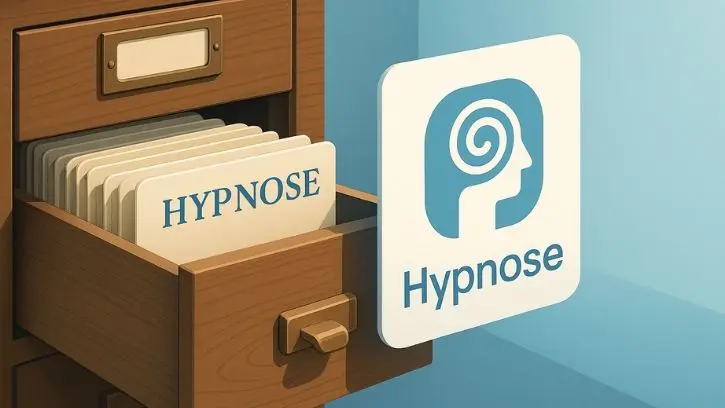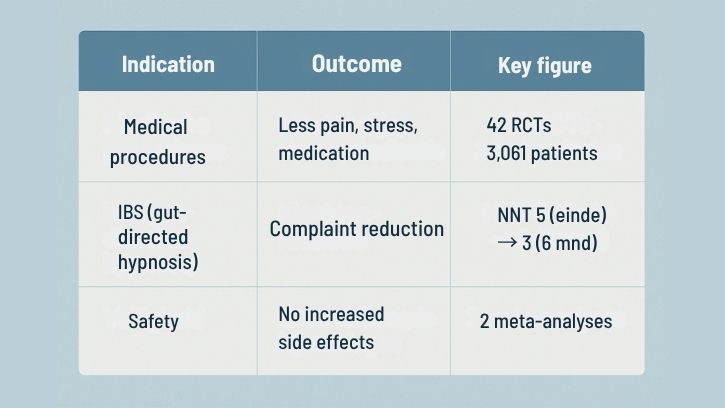
Medical hypnosis scientifically proven applications and results in healthcare settings. In this article we show why medical hypnosis is scientifically proven and how to apply it responsibly.
Is medical hypnosis scientifically proven? Yes. For centuries, people considered hypnosis a fringe phenomenon, but recent scientific research shows that doctors use medical hypnosis effectively for concrete medical problems. A major German systematic review in the renowned journal Deutsches Ärzteblatt International(2016) presents the facts.The Efficacy, Safety and Applications of Medical Hypnosis – A Systematic Review of Meta-analyses The conclusion? Medical hypnosis works safely, effectively and is ready for integration into mainstream care.
But where exactly does hypnosis stand? Between the consulting room of hypnotherapist and the operating table of the teaching hospital. Between ancient traditions and modern meta-analyses. This is the story of an ancient technique being reinvented – this time based on hard scientific evidence.
Medical hypnosis scientifically proven: what do meta-analyses say?
Let’s start with the numbers. German researchers led by Häuser analyzed 391 scientific publications on medical hypnosis,[2] from which they selected five high-quality meta-analyses that together looked at thousands of patients. The results are remarkably consistent.
Effectiveness in Medical Procedures
Medical hypnosis scientifically proven effects are seen here in less pain, stress and medication use.
In 34 randomized controlled trials (RCTs) with 2,597 patients, hypnosis was found to be superior to standard treatment for:
- Emotional stress during medical procedures (effect size ranging from low to high)
- Pain during procedures (low but significant effect size)
- Medication use (significantly lower)
- Recovery time (faster recovery)
- Operating time (shorter procedures)[3]
These are not subjective experiences or anecdotes. These are hard, tested data from controlled trials where patients were randomly assigned to hypnosis or control treatment.
The Irritable Bowel Syndrome: A Success Story
Even more impressive are the results in IBS (Irritable Bowel Syndrome). In eight RCTs involving 464 patients, gut-directed hypnosis shows these figures:
- NNT (Number Needed to Treat) of 5 at the end of treatment
- NNT of 3 at follow-up at six months[4]
What does this mean? For every five patients you treat with hypnosis, one patient has significantly fewer symptoms than with standard treatment. After six months, this improved to one in three. Those are numbers many a drug would envy.
Important detail: many of these studies included patients who did not respond to medication. So hypnosis worked in people for whom other treatments failed.
Safety: No Increased Risk
Two meta-analyses looked specifically at side effects. The results? No increased side effects compared with control groups.[5] In IBS studies, only one patient reported dizziness (but continued treatment), and one patient discontinued because of a panic seizure during hypnosis.
This is remarkably favorable compared to drug treatments, which often do have significant side effects.
 The Crossroads: Where Does Hypnosis Stand Now?
The Crossroads: Where Does Hypnosis Stand Now?
The position of medical hypnosis in 2025 is paradoxical. On the one hand, growing scientific evidence and increasing acceptance. On the other, lingering biases and implementation challenges. Let’s look at both sides.
Growing Acceptance in Regular Care
In several countries, we see concrete steps toward integration:
Germany: About 3,000 dentists are trained in hypnosis through the Deutsche Gesellschaft für Zahnärztliche Hypnosis (DGZH),[6] more than 600 of whom actively offer hypnosis in their practices. They use it for anxiety, vomiting reflex, intolerance to local anesthesia and craniomandibular dysfunction.
Belgium: Liège University Hospital has treated more than 8,000 surgical patients with “hypnosedation” – a combination of hypnosis, light sedation and local anesthesia.[7] Patients remain conscious during surgeries that normally require general anesthesia.
UK, Austria, US: Gastroenterology departments integrate hypnosis into their treatment of functional gastrointestinal disorders.[8] Patients receive live sessions or audio files for home use.
Netherlands: The German review does not cite Dutch figures, but implementation is growing. Hospitals are running pilots with hypnosis in children, psychosomatic clinics are offering hypnotherapy, and HypnoseMentor is training departments such as OR, Intensive Care, Mother and Child, Ophthalmology, Oral Surgery and X-ray in both medical communication and applied hypnosis techniques.
Lasting Barriers
But integration is not without obstacles:
Public perception: The biggest obstacle is the association with show-hypnosis. People think of someone standing on stage and making people cluck like chickens. Those images are hard to erase.
Training: Many doctors have minimal to no training in hypnosis during their studies. In Germany, basic training of only 32 hours is required to declare hypnosis,[9] which is little for a technique with so much nuance.
Methodological challenges: Many RCTs have methodological limitations. Blinding (hiding who gets what treatment) is virtually impossible in hypnosis. This makes studies more vulnerable to bias. [10]
Evidence for specific indications: Evidence is still limited for some applications. The German review deliberately focused on meta-analyses with at least 400 patients. Fourteen other meta-analyses were excluded because they included too few patients. [11]
Applications: From Operating Room to General Practice
The versatility of medical hypnosis is astounding. Let’s explore the various areas of application.
1. Anesthesiology and Surgery
Preoperative anxiety and stress
For many patients, the fear of surgery is at least as stressful as the procedure itself. Hypnosis has been found to be effective in reducing that anxiety, with significant reductions in emotional stress. [12]
The application is simple: patients are given a hypnosis session or audio file before surgery. They learn self-soothing techniques and positive suggestions.
Hypnosedation: A New Standard?
The Belgian experience with hypnosis is groundbreaking. More than 8,000 patients underwent operations in which hypnosis replaced general anesthesia.[13] Consider:
- Plastic surgery
- Minor general surgery
- Even aortic bypass surgery
Patients remain conscious but experience minimal pain and anxiety. Benefits:
- Faster recovery (no aftermath of anesthesia)
- Less medication (lower cost, fewer side effects)
- Patient can communicate during surgery
- Shorter operation time
Awake Brain Surgery
One particular application is the awake-awake-awake technique in brain surgery.[14] Patients remain awake throughout the procedure – without any sedation. They receive only local anesthesia of the scalp.
This is necessary in surgery near areas of speech or movement. The neurosurgeon needs to be able to test whether he is affecting important areas. With hypnosis, patients remain calm and can perform neurological tests while the surgeon operates in their brain.
Hypnosis focuses on:
- Dissociation to an inner place of rest
- Reinterpretation of sensory sensations
- Recalling positive memories
2. Gastroenterology
IBS: The Best Evidence
For irritable bowel syndrome, the evidence is strongest. Eight RCTs with 464 patients consistently show positive effects. [15]
Gut-directed hypnosis is a specific protocol developed for IBS. It focuses on:
- Normalizing bowel movements
- Reducing hypersensitivity
- Addressing emotional triggers
- Strengthening sense of control
Patients typically receive 8-12 sessions over 12 weeks. Alternative: audio files for home use. A Dutch RCT showed no difference in effectiveness between live sessions and CDs in children. [16]
Importantly, the effects are maintained. The NNT even improves from 5 to 3 between end of treatment and 6-month follow-up.[17] This suggests that patients continue to benefit and may continue to use the techniques independently.
Endoscopies Without Sedation
Gastrointestinal bleeding is unpleasant. By default, patients are given sedation. But with hypnosis, many endoscopies can be done without sedation. [18]
Advantages:
- No recovery period (straight home)
- No side effects of sedatives
- Lower costs
- Patient can watch on screen
Some German hospitals routinely offer this with audio files.
3. Dentistry
Widely Implemented
Dentistry is leading the way in implementation. In Germany, 3,000 dentists have been trained, 600+ of whom offer hypnosis. [19]
Indications:
- Fear of dentist (dentophobias often cannot be treated differently)
- Vomiting reflex (sometimes makes treatment impossible)
- Intolerance of local anesthesia (rare but problematic)
- Craniomandibular dysfunction (jaw pain)
Practical Implementation
Dentists use different models:
- Audio files: Special CDs for dental treatment. Track 1 induces hypnosis, track 2 awakens patient. Dentist puts track 1 on repeat, does treatment, starts track 2 at the end.
- Hypnosis Assistant: Trained team member does hypnosis while dentist treats. Dentist must also be trained to handle any problems.
- Dentist himself: Induces hypnosis before treatment begins. Takes 2-5 minutes for relaxation before injection, ~10 minutes for treatment without anesthesia.
- Nitrous oxide + hypnosis: Popular combination. Nitrous oxide increases suggestibility and reduces anxiety. Hypnosis enhances the effect.
- External hypnotist: In complex cases (severe anxiety, jaw problems), some dentists use an external hypnotherapist.
4. Waking Suggestions: Low-threshold Application.
Powerful Words Without Trance
Perhaps the most accessible application: positive suggestions without formal trance induction. Five RCTs show effectiveness in various medical procedures. [20]
Proven Effective At:
- Radiological procedures (3 RCTs).
- Positive suggestions + empathy reduce pain and anxiety
- Less pain medication needed
- Shorter procedure duration
- Blood sampling (1 RCT).
- “I’m going to start now” vs. “This is going to hurt.”
- First group: mean pain 1.6 on 0-10 scale
- Second group: average pain 2.7
- 58% vs. 4% experienced moderate to severe pain[21].
- Spinal/epidural anesthesia (1 RCT).
- Positive instruction: “We’re going to sedate you so it’s comfortable”
- Negative instruction: “You will feel a stinging and burning sensation as if a bee stings you.”
- Difference: median 3 vs. 5 on 11-point scale[22]
Not Effective:
- Waking suggestion in acute headache in emergency department (1 RCT)[23]
- Suggestion “This is a powerful painkiller” increased effect diclofenac not
- Possibly too acute and intense for subtle suggestive effects
Principles for Effective Communication
The German review provides concrete recommendations for physician-patient communication:[24]
Avoid:
- Negations (“No worries,” “Don’t be nervous”)
- Pain focus (“How much pain do you have?”)
- Threatening language (“This is going to hurt”)
Usage:
- Positive wording (“We take good care of you”)
- Stress safety (“We are watching you closely”)
- Respect autonomy (“You can always let us know what you need”)
- Combining explanations with positive suggestions
Examples in premedication:
- ❌ “You don’t have to worry.”
- ✅ “Everything will be fine, we are doing this together”
- ❌ “After surgery, you may have pain.”
- ✅ “We make sure you stay comfortable during recovery.”
- ❌ “This may sting”
- ✅ “I am now going to give the anesthesia for your comfort.”
Live Hypnosis vs. Audio Files
Mixed Results
A practical question for implementation: do audio files work as well as live hypnosis?
The answer is nuanced. One meta-analysis found no difference in effectiveness.[25] Another meta-analysis found that only live hypnosis significantly reduced postoperative anxiety and pain, but both reduced nausea and medication use.[26]
Authors’ interpretation: live hypnosis provides the context of a personal relationship, which is more important for anxiety and pain. For more physiological responses (nausea, drug cravings), the suggestion content is more important than the setting.
Practical Implications:
- Audio files are more cost-effective and scalable
- For anxiety/pain reduction: prefer live sessions or personal audio
- For IBS/gastro: audio works fine (NL study in children[27])
- Dentistry: combination works well (basic with audio, live for complex cases)
Methodological Quality: Critical Notes
The Evidence Is Not Perfect
The German review is honest about limitations. Of the five meta-analyses included:[28]
- 1 high methodological quality
- 3 average quality
- 1 low quality
Many underlying RCTs have high or unclear bias risks according to the Cochrane Risk of Bias Tool.[29]
Why These Restrictions?
- Blinding impossible: You cannot keep patients and therapists blind to whether they are receiving hypnosis. This increases risk of placebo effects and expectancy effects.
- Small effect sizes: Especially for pain, effects are modest. This is partly inherent (pain is complex and difficult to influence), partly possible due to methodological limitations.
- Heterogeneity: Studies vary in:
- Type of hypnosis (live, audio, self-hypnosis)
- Duration and number of sessions
- Specific techniques
- Type of control treatment
- Measured outcomes
- Publication bias: Studies with positive results are more likely to be published. Unknown is how many negative studies remained in the drawer.
Significance for Practice
Despite these limitations, the authors conclude that medical hypnosis is effective and safe for:[30]
- Reduction of pain and emotional stress in medical procedures
- Treatment IBS
- Waking suggestions in physician-patient communication
The evidence is not perfect, but sufficiently strong for implementation as a complementary technique. Not as a substitute for necessary medical care, but as a complement.
Historical Perspective: Vol Circles
19th Century: The First Wave
It is not a new phenomenon. Scottish surgeon James Esdaile performed more than 345 major operations in India between 1845-1851 using “mesmerism” – the precursor to hypnosis. [31]
His results:
- Amputations of arms, legs, breasts
- Major tumor removals
- Good pain relief
- Low mortality
But ether anesthesia was introduced in 1846, followed by chloroform in 1847. Mesmerism quickly faded into the background. Why bother with a mental technique when you can just put patients to sleep?
Early 20th Century: Medical Recognition
- 1892: British Medical Association (BMA) recommends hypnosis for pain, sleep disorders and functional symptoms[32].
- 1955: BMA reaffirms medical use based on case reports[33]
- 1958: American Medical Association follows[34]
But these were not yet RCTs. Evidence was based on expert consensus and case series.
21st Century: Evidence-Based Renaissance
Only now do we have the tools to really test hypnosis:
- Randomized controlled trials
- Meta-analyses
- Systematic reviews
- Brain imaging (fMRI, EEG) to understand mechanisms
And the results are positive. We are making a full circle: from widely accepted (19th century), to fringe phenomenon (20th century), to evidence-based intervention (21st century).
Neurobiology: What Happens in the Brain?
No Sleep, No Ordinary Waking State
EEG and fMRI show that hypnotic trance is a unique state,[35] distinct from:
- Normal waking state
- Sleep
- Deep relaxation
- Meditation
Characteristics Hypnotic Trance:
- Changed perception of time
- Selective amnesia
- Possible regression to younger age
- Strong inner focus (absorption)
- Increased suggestibility[36]
fMRI Findings
A recent article in the journal Hypnosis describes fMRI research:[37]
- Different brain connectivity in light (HS1) and deep hypnosis (HS2)
- Lingual gyrus is consistently important node
- Patterns differ from normal waking state
This supports that hypnosis is a real neurophysiological state, not role-play or pure imagination.
Practical Implementation: What Now?
For Healthcare Professionals
- Start with waking suggestions: Minimal training required, immediately applicable, scientifically based[38].
- Watch your choice of words
- Avoid negative suggestions
- Emphasize safety and support
- Consider basic training: Several institutes in the Netherlands offer accredited training.
- Use audio files: For IBS and anxiety reduction, these are cost-effective and proven effective.[40]
- Refer: For complex cases to specialized hypnotherapists.
For Patients
- Discuss with your doctor: Especially with IBS, chronic pain, fear of medical procedures.
- Find qualified therapist: Notice:
- Recognized training
- Experience with your specific complaint
- Staying Realistic: Hypnosis is not a panacea, but proven effective complementary technique.
- Audio options: For IBS and anxiety reduction, self-help audio programs are an approachable option.
Conclusion: The Crossroads as an Opportunity
Medical hypnosis scientifically proven in practice
Medical hypnosis scientifically proven protocols can be found in our trainings and materials.
- Read more about OMNI Hypnosis Training Center® medical hypnosis research Read more
- Learn more about our medical courses Discover the courses
- Free trial hypnosis classes: Start free classes immediately
Medical hypnosis is indeed at a crossroads. But this is not a choice between two directions. It is a convergence point where different traditions converge:
- Ancient wisdom meets modern science
- Clinical experience is evidence-based
- Alternative transforms to complementary
- Fringe phenomenon moves to mainstream
The German systematic review[42] is a landmark. It shows that medical hypnosis:
- ✅ Effective for specific indications
- ✅ S afe (no increased side effects)
- ✅ Cost-effective is
- ✅ Implementable (from audio to live sessions)
- ✅ Complementary is (not a replacement essential care)
The question is no longer “Does hypnosis work?” That has been answered. The question is, “How do we integrate this effective technique as widely as possible into mainstream care?”
For patients with IBS who do not respond to medication, for children who are anxious about medical procedures, for adults who need surgeries – for all these people, hypnosis is now an evidence-based option.
The crossroads at which hypnosis stands is one of opportunity. Opportunities to help patients better. Opportunities to cut costs. Opportunities to bridge the gap between body and mind, between alternative and mainstream, between old and new.
The direction is clear. The evidence is there. Now it’s time for implementation —-.
Sources and References
Main source:
[1] Häuser W, Hagl M, Schmierer A, Hansen E. The Efficacy, Safety and Applications of Medical Hypnosis: A Systematic Review of Meta-analyses. Dtsch Arztebl Int. 2016;113(17):289-296.
DOI: 10.3238/arztebl.2016.0289
PubMed: PMID: 27191327
Publication details:
- Journal: Deutsches Ärzteblatt International (peer-reviewed medical journal)
- Year: 2016
- Type: Systematic review of meta-analyses
- Period studied: January 2005 – June 2015
- Databases: Cochrane CDSR, DARE, PubMed
- Inclusion criteria: Meta-analyses with at least 400 patients
- Studies included: 5 meta-analyses from 391 publications found
- Total number of RCTs: 42 randomized controlled trials
- Total number of patients: 3,061 patients
Authors and affiliations:
- PD Dr. Winfried Häuser: Klinikum Saarbrücken & Technische Universität München
- Dr. Maria Hagl: Ludwig-Maximilians-Universität München
- Dr. Albrecht Schmierer: Stuttgart dental practice
- Prof. Ernil Hansen: Universitätsklinikum Regensburg
Methodological quality assessment:
The methodological quality of the included meta-analyses was assessed with AMSTAR (A Measurement Tool to Assess Systematic Reviews):
- 1 meta-analysis: high quality (score 9-11)
- 3 meta-analyses: average quality (score 5-8)
- 1 meta-analysis: low quality (score 0-4)
Included meta-analyses:
[2] Kekecs Z, Nagy T, Varga K. The effectiveness of suggestive techniques in reducing postoperative side effects: a meta-analysis of randomized controlled trials. Anesth Analg. 2014;119(6):1407-1419.
[3] Madden K, Middleton P, Cyna AM, Matthewson M, Jones L. Hypnosis for pain management during labor and childbirth. Cochrane Database Syst Rev. 2012;11:CD009356.
[4] Schaefert R, Klose P, Moser G, Häuser W. Efficacy, tolerability, and safety of hypnosis in adult irritable bowel syndrome: systematic review and meta-analysis. Psychosom Med. 2014;76(5):389-398.
[5] Schnur JB, Kafer I, Marcus C, Montgomery GH. Hypnosis to manage distress related to medical procedures: a meta-analysis. Contemp Hypn. 2008;25(3-4):114-128.
[6] Tefikow S, Barth J, Maichrowitz S, et al. Efficacy of hypnosis in adults undergoing surgery or medical procedures: a meta-analysis of randomized controlled trials. Clin Psychol Rev. 2013;33(5):623-636.
About This Blog
This comprehensive analysis is based on the systematic review “The Efficacy, Safety and Applications of Medical Hypnosis” by Häuser et al [1], published in the peer-reviewed journal Deutsches Ärzteblatt International(2016).
All medical claims in this article are supported by references to this scientific article and the meta-analyses analyzed therein. The review meets the highest scientific standards and follows the Cochrane Collaboration’s guidelines for systematic reviews.
Reliability of source:
- Peer-reviewed publication in reputable medical journal
- Systematic analysis of 391 scientific publications
- Inclusion of only meta-analyses with at least 400 patients
- Methodological quality assessment with validated instrument (AMSTAR)
- Transparent reporting of constraints and bias risks
Disclaimer
This article presents its own analysis and interpretation of published scientific research. All information is based on peer-reviewed literature (see sources), but the structure, perspective, examples and conclusions are original work of HypnosisMentor. This article is intended for educational purposes and does not constitute medical advice. Always consult a qualified health care provider for medical decisions.
Key points:
- Medical hypnosis is a complementary technique, not a substitute for necessary medical care
- Always discuss with your treating physician whether hypnosis is appropriate for your specific situation
- For acute or serious medical complaints: always consult regular medical care first
Copyright © 2025 HypnosisMentor | All rights reserved.



 The Crossroads: Where Does Hypnosis Stand Now?
The Crossroads: Where Does Hypnosis Stand Now?